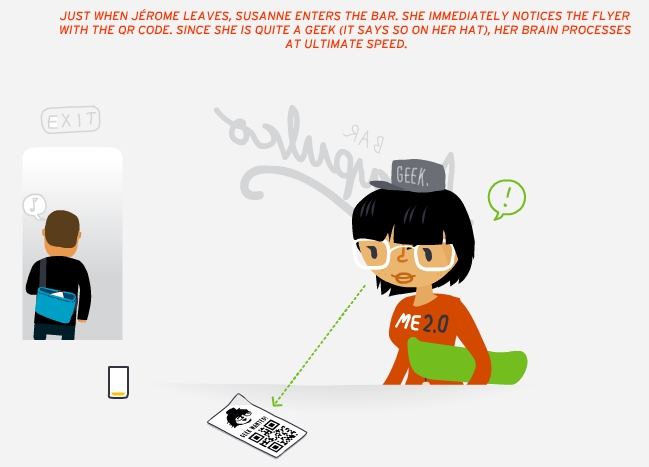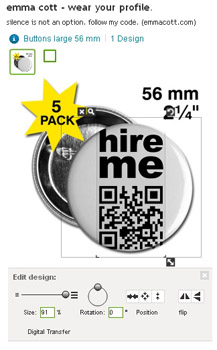Archive for the ‘pattern recognition’ Category
Human writable, Machine readable: QR codes
Physical tokens, digital presence
New shirt idea: QR a QT!
I figure I can start writing about an emerging technology once it hits Kanye West’s blog.
From my rigorous research, I learned that Q(uick) R(esponse) codes are like barcodes, with information that you can scan, decode, and get some kind of data from — usually a website, text, or an image.
They’re cheap to make and use, and you can slap them on billboards, mugs, paper, virtually any surface (spray painted onto asphalt, collated into a “living book“).
You use a a mobile phone as a decoder to snap the QR’s picture, and decode the information that will lead you somewhere else in the digital world. If the purpose of QR sounds vague and open-ended, that’s cause it is!
For a QR scanner, try the Kaywa Reader. If anything, you should check out the illustrated “story” on the home page, which explains QR as a treasure-hunt serendipity factor for nerds, with the closing moral being “The early nerd gets the QR code!”
On a trendspotting note, I have yet to see QR codes out and about in everyday life. How will I ever get that micro-platform-blogging dream job like Susanne above??
Big in Japan
Japan’s had QR forever (from Denso-Wave’s work for the Japanese auto manufacturing industry in the mid-1990’s) but it’s now resurfacing, likely tied to the rise of personal mobile phone use. QR codes are often used as a promotional tactic — gaining you entrance to “Try-vertising” sampling salons in Tokyo, for example.
If you’re not a big ad agency, perhaps you’re using QR codes to help mobile technology in developing countries. In India, 40% of the rural population are illiterate. This population is challenged the text-based format and confusing iconography of mobile phones. Experience design consultancy Adaptive Path came up with a video sketch for MobileGlyph, a system of using QR codes to capture photos and information about contacts that can be used in an easy user interface, without having to rely on text or numbers.
Personal Branding
For a BRAND YOU bent, Emma Cott turns QR codes into wearable art “through a beautiful and elegant code concealing your hidden message.” In other words, you customize a QR code and stick it on a t-shirt or a button. The open code creator is simple: enter your URL website, pick a motive (HIRE ME, ADD ME, DATE ME, BUY ME, or customize your own) and out comes a custom generated QR patch.
Here’s mine for Indienomics. (Besides “Hire Me”, I can think of some other motivations I want to silently and mysteriously communicate to people. Ahem.)
Emotional design
QR codes are kind of ugly, aren’t they? The Marc Jacobs one is cute only because it’s blocked by a cute illustration of “Miss Marc.” I think the design aesthetic flaw of the QR code is a small part of what Microsoft Tag is trying to conquer. No ugly, black-and-white pixelated squares there! You can create, customize, and color your own series of machine readable codes…. even using, yes, PowerPoint as a design tool! (The design aspect is no small part of our perception of a product’s functionality. This is why Donald Norman’s Emotional Design book is on my reading list. And also because Matt mentioned it.)
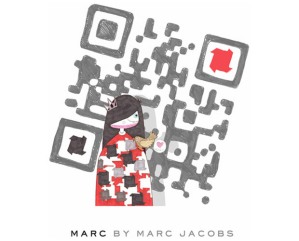
“Miss Marc” QR code for Japanese mobile website, launching today.
via Hypebeast
**7/2/09 UPDATE:
Vizitag, a startup in the “mobile tag management system” industry, had a good FAQ that answered at least two of my questions:
I Already Have a Website – Why Do I Need Vizitags?
These days, every business has a website chock full of content but you have to find it, visit it and search it to find what you want. Vizitags are designed for the ‘mobile generation’ who expect instant information gratification via the phone they carry with them everywhere.
In practice it doesn’t take much longer to load the reader and snap a tag as to load a browser and click a bookmark to go to a web page. The difference is that snapping a Vizitag will display some very specific and useful information immediately on your mobile and/or email you some targeted content that you can refer to straightaway or later.
What’s the Difference Between a Vizitag and Barcodes/RFID?
Barcodes are normally used to identify products – for example for the purposes of pricing them, stock taking or asset management. Barcodes usually require fixed or handheld scanning hardware and convert a specific alphanumeric code – like a Universal Product Code (UPC) – into a black-and-white bar image.
A RFID chip is a piece of hardware that can act in passive or active mode to be read or to read/write data and requires fixed or handheld readers. RFID chips are often used to track products through a supply chain for inventory control and lifecycle tracking purposes. Unlike a Vizitag, RFID chips cost money to buy the device itself. They are also more vulnerable to damage and therefore could be subject to replacement costs.
The next Big Idea — the insaner, the better
What’s a meta for?
Metaphor has scandalized philosophers, including both scholastics and semiotics, because it seems to be wrong: It asserts an identity between two different things. And it is wrongest when it is most beautiful.
– Walker Percy, The Message in the Bottle
Like the artist with collage, the author who arranges a metaphor has to ask — will it blend? That is, will the two disparate concepts come together and create a metaphor of new meaning?
Shakespeare says the world’s a stage. Life, to Forrest Gump, is a box of chocolates. A dream deferred, says Langston Hughes, is a raisin in the sun.
Creating and marketing nonsensical products
Big Think Strategy — a book from marketing maven Berndt Schmitt — continues this line of reasoning. What are the seemingly unrelated ideas we can pull together to inject new life and meaning to a brand?
Schmitt likes to rip up magazines to mix the metaphors.
The Big Idea is a card game you can play for the same effect:
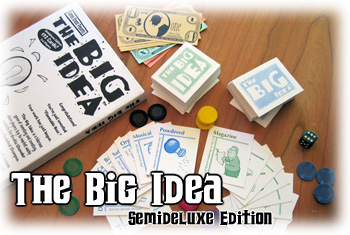
Game theory + chaos theory = idea generation
The deck of cards features nouns and adjectives. Mix and match the cards, then try to market and pitch the resulting wacky products — Erotic Chowder, Mentholated Shampoo.
Sumana H. — intrepid marketer when she wants to be, and a previous interviewee — brought my attention to this game, by way of her pitched ads for these nonsensical products:
- Edible High-Priority Chowder, to cure anxiety of choice at the salad bar
- Herbal Natural Chainsaw, strong enough for a logger but made for a hippie
- Networked Beer, to ensure you never feel like you’re drinking alone [Ed. note: Isn’t that what meetups are for?]
Cheapass Games, the cheeky manufacturers of this boardgame, challenge your marketing wits: “Do you think you’re the marketing whiz who can talk the public into a Perforated Kilt? Then you’re ready to play The Big Idea!”
[Note: Cheapass Games is an indie-nomics enterprise on its own, noting that most games are overpriced and generic. Dice, pencils, plastic parts — “these generic bits and pieces can account for as much as 75% of a game’s production cost, and that cost gets handed to you.”]
Not just a game: wacky product/service combos in real life
These (seemingly) nonsensical products — and services — are the wave of the entrepreneurial future folks! Just scroll through the list at Springwise.com, a running tally of new business ideas just ridiculous enough to work.
Like this, my current favorite — a mashup of current obsessions:
Collage, and the art of marketing strategy
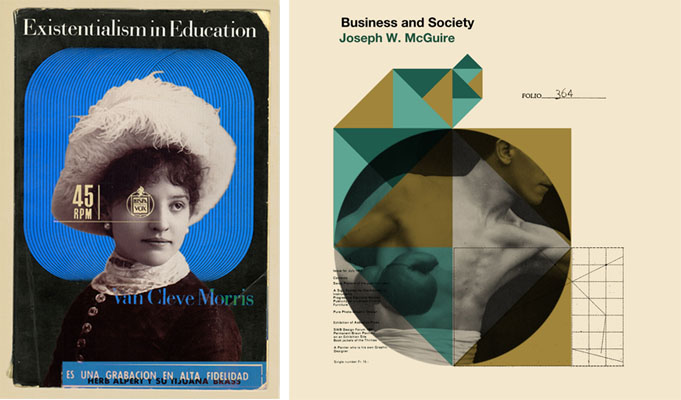
illus. by Cristiana Coucerio
Synergy
Collage: arranging disparate scraps into a meaningful whole.
In the hands of an artist, collage can be an artful blend of figure, type, annotation.
In the hands of Bernd Schmitt, collage can be a strategic business tool.
Schmitt — professor at Columbia’s B-School, director of its Center on Global Brand Leadership and, consequentially, Matt’s boss’s boss — sees collage as a tool that helps managers “encourage unusual connections in the brain.”
Combining the (seemingly) incompatible
Here’s an exercise Schmitt likes: rip up magazines and create a visual board of brands and business trends. Now, pair the two randomly.
Say you have a Coca-cola ad, and an article on the green movement. How would you design a campaign strategy around this combination? What are the challenges and advantages to the brand’s positioning?
“It is key to pair concepts that seem incompatible because they stretch people’s imagination and facilitate the formation of unusual connections.”
To read Schmitt’s full explanation of the collage exercise, search for the term in his book Big Think Strategy (2007).
